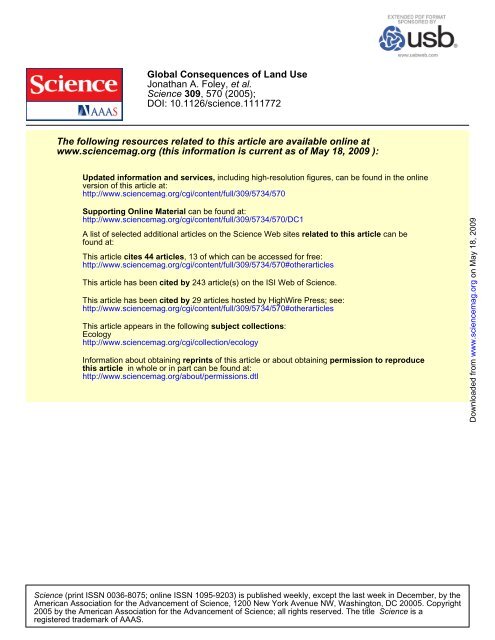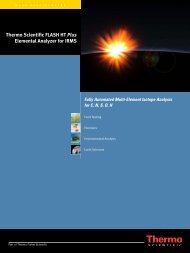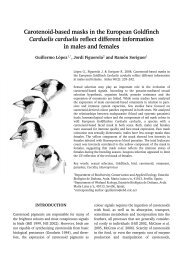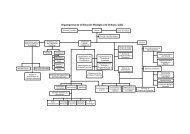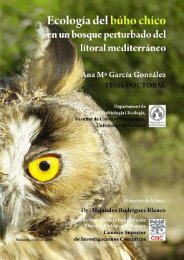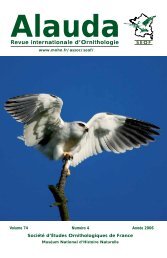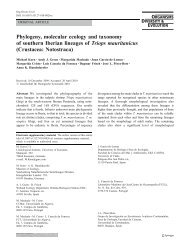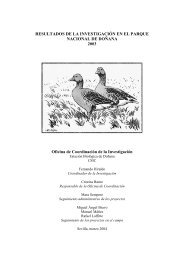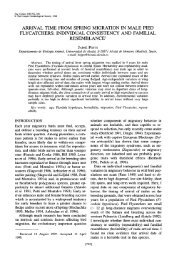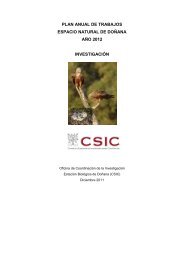DOI: 10.1126/science.1111772 , 570 (2005); 309 Science et al ...
DOI: 10.1126/science.1111772 , 570 (2005); 309 Science et al ...
DOI: 10.1126/science.1111772 , 570 (2005); 309 Science et al ...
You also want an ePaper? Increase the reach of your titles
YUMPU automatically turns print PDFs into web optimized ePapers that Google loves.
Glob<strong>al</strong> Consequences of Land UseJonathan A. Foley, <strong>et</strong> <strong>al</strong>.<strong>Science</strong> <strong>309</strong>, <strong>570</strong> (<strong>2005</strong>);<strong>DOI</strong>: <strong>10.1126</strong>/<strong>science.1111772</strong>The following resources related to this article are available online atwww.sciencemag.org (this information is current as of May 18, 2009 ):Updated information and services, including high-resolution figures, can be found in the onlineversion of this article at:http://www.sciencemag.org/cgi/content/full/<strong>309</strong>/5734/<strong>570</strong>Supporting Online Materi<strong>al</strong> can be found at:http://www.sciencemag.org/cgi/content/full/<strong>309</strong>/5734/<strong>570</strong>/DC1A list of selected addition<strong>al</strong> articles on the <strong>Science</strong> Web sites related to this article can befound at:This article cites 44 articles, 13 of which can be accessed for free:http://www.sciencemag.org/cgi/content/full/<strong>309</strong>/5734/<strong>570</strong>#otherarticlesThis article has been cited by 243 article(s) on the ISI Web of <strong>Science</strong>.This article has been cited by 29 articles hosted by HighWire Press; see:http://www.sciencemag.org/cgi/content/full/<strong>309</strong>/5734/<strong>570</strong>#otherarticlesThis article appears in the following subject collections:Ecologyhttp://www.sciencemag.org/cgi/collection/ecologyInformation about obtaining reprints of this article or about obtaining permission to reproduc<strong>et</strong>his article in whole or in part can be found at:http://www.sciencemag.org/about/permissions.dtlDownloaded from www.sciencemag.org on May 18, 2009<strong>Science</strong> (print ISSN 0036-8075; online ISSN 1095-9203) is published weekly, except the last week in December, by theAmerican Association for the Advancement of <strong>Science</strong>, 1200 New York Avenue NW, Washington, DC 20005. Copyright<strong>2005</strong> by the American Association for the Advancement of <strong>Science</strong>; <strong>al</strong>l rights reserved. The title <strong>Science</strong> is aregistered trademark of AAAS.
R EVIEWin ecosystem services, including many thatare important to agriculture.Freshwater ResourcesLand use can disrupt the surface waterb<strong>al</strong>ance and the partitioning of precipitationinto evapotranspiration, runoff, and groundwaterflow. Surface runoff and river dischargegener<strong>al</strong>ly increase when natur<strong>al</strong> veg<strong>et</strong>ation(especi<strong>al</strong>ly forest) is cleared (25, 26). Forinstance, the Tocantins River basin in Brazilshowed a È25% increase in river dischargeb<strong>et</strong>ween 1960 and 1995, coincident with expandingagriculture but no major change inprecipitation (26).Water demands associated with land-usepractices, especi<strong>al</strong>ly irrigation, directly affectfreshwater supplies through water withdraw<strong>al</strong>sand diversions. Glob<strong>al</strong> waterwithdraw<strong>al</strong>s now tot<strong>al</strong>È3900 km 3 yr j1 ,orÈ10%of the tot<strong>al</strong> glob<strong>al</strong> renewableresource, and the consumptiveuse of water (notr<strong>et</strong>urned to the watershed) isestimated to be È1800 to2300 km 3 yr j1 (22, 27)(fig.S3A). Agriculture <strong>al</strong>one accountsfor È85% of glob<strong>al</strong>consumptive use (22). As aresult, many large rivers, especi<strong>al</strong>lyin semiarid regions,have greatly reduced flows,and some routinely dry up(21, 28). In addition, theextraction of groundwaterreserves is <strong>al</strong>most univers<strong>al</strong>lyunsustainable and hasresulted in declining watertables in many regions(21, 28) (fig.S2,BandC).Water qu<strong>al</strong>ity is oftendegraded by land use. Intensiveagriculture increaseserosion and sediment load,and leaches nutrients andagricultur<strong>al</strong> chemic<strong>al</strong>s togroundwater, streams, and100 %proportion of landscape0 %natur<strong>al</strong>ecosystemsrivers. In fact, agriculture has become thelargest source of excess nitrogen and phosphorusto waterways and coast<strong>al</strong> zones (12, 29).Urbanization <strong>al</strong>so substanti<strong>al</strong>ly degrades waterqu<strong>al</strong>ity, especi<strong>al</strong>ly where wastewater treatmentis absent. The resulting degradation ofinland and coast<strong>al</strong> waters impairs water supplies,causes oxygen depl<strong>et</strong>ion and fish kills,increases blooms of cyanobacteria (includingtoxic vari<strong>et</strong>ies), and contributes to waterbornedisease (12, 30).Forest ResourcesLand-use activities, primarily for agricultur<strong>al</strong>expansion and timber extraction, have caused an<strong>et</strong> loss of È7to11millionkm 2 of forest in thepast 300 years (17, 32, 33). Highly managedforests, such as timber plantations in NorthAmerica and oil-p<strong>al</strong>m plantations in SoutheastAsia, have <strong>al</strong>so replaced many natur<strong>al</strong> forestsand now cover 1.9 million km 2 worldwide (31).Many land-use practices (e.g., fuel-woodcollection, forest grazing, and road expansion)can degrade forest ecosystem conditions—interms of productivity, biomass, stand structure,and species composition—even withoutchanging forest area. Land use can <strong>al</strong>so degradeforest conditions indirectly by introducingpests and pathogens, changing fire-fuelloads, changing patterns and frequency of ignitionsources, and changing loc<strong>al</strong> m<strong>et</strong>eorologic<strong>al</strong>conditions (34).In many parts of the world, especi<strong>al</strong>ly inEast Asian countries, reforestation and afforestationare increasing the area of forestedfrontierclearingssubsistenceagricultureandsm<strong>al</strong>l-sc<strong>al</strong>efarmspre-s<strong>et</strong>tlement frontier subsistence intensifying intensivestage in land use transitionlands (35). Furthermore, forest managementin many regions is acting to improve forestconditions. For example, inadvertent nitrogenfertilization, peatland drainage, and direct managementefforts increased the standing biomassof European forests by È40% b<strong>et</strong>ween1950 and 1990, while their area remainedlargely unchanged (36, 37). These forests havebecome a substanti<strong>al</strong> sink of atmosphericcarbon (È0.14 Pg C yr j1 in the 1990s) (37),<strong>al</strong>though other ecosystem services (includingthose provided by peatlands) and biodiversityare likely diminished.protected/recreation<strong>al</strong> landsintensiveagricultureurbanareas?Fig. 1. Land-use transitions. Transitions in land-use activities that may be experiencedwithin a given region over time. As with demographic and economic transitions, soci<strong>et</strong>iesappear <strong>al</strong>so to follow a sequence of different land-use regimes: from pres<strong>et</strong>tlement natur<strong>al</strong>veg<strong>et</strong>ation to frontier clearing, then to subsistence agriculture and sm<strong>al</strong>l-sc<strong>al</strong>e farms,and fin<strong>al</strong>ly to intensive agriculture, urban areas, and protected recreation<strong>al</strong> lands. Differentparts of the world are in different transition stages, depending on their history,soci<strong>al</strong> and economic conditions, and ecologic<strong>al</strong> context. Furthermore, not <strong>al</strong>l parts ofthe world move linearly through these transitions. Rather, some places remain in onestage for a long period of time, while others move rapidly b<strong>et</strong>ween stages. [Adaptedfrom (1) and (2)]Region<strong>al</strong> Climate and Air Qu<strong>al</strong>ityLand conversion can <strong>al</strong>ter region<strong>al</strong> climatesthrough its effects on n<strong>et</strong> radiation, the divisionof energy into sensible and latent heat,and the partitioning of precipitation into soilwater, evapotranspiration, and runoff. Modelingstudies demonstrate that land-cover changesin the tropics affect climate largely throughwater-b<strong>al</strong>ance changes, but changes in temperateand bore<strong>al</strong> veg<strong>et</strong>ation influence climateprimarily through changes in the surface radiationb<strong>al</strong>ance (38). Large-sc<strong>al</strong>e clearing oftropic<strong>al</strong> forests may create a warmer, drierclimate (39), whereas clearing temperate andbore<strong>al</strong> forest is gener<strong>al</strong>ly thought to cool theclimate, primarily through increased <strong>al</strong>bedo(40) (table S2, A and B).Urban ‘‘heat islands’’ are an extreme caseof how land use modifies region<strong>al</strong> climate.The reduced veg<strong>et</strong>ation cover, impervioussurface area, and morphology of buildings incityscapes combine to lowerevaporative cooling, storeheat, and warm the surfaceair (41). A recent an<strong>al</strong>ysisof climate records in theUnited States suggests thata major portion of the temperatureincrease during thelast sever<strong>al</strong> decades resultedfrom urbanization and otherland-use changes (9). Landcoverchange has <strong>al</strong>so beenimplicated in changing theregion<strong>al</strong> climate in China;recent an<strong>al</strong>yses suggest thatthe daily diurn<strong>al</strong> temperaturerange has decreased asa result of urbanization (42).Land-use practices <strong>al</strong>sochange air qu<strong>al</strong>ity by <strong>al</strong>teringemissions and changingthe atmospheric conditionsthat affect reaction rates,transport, and deposition.For example, troposphericozone (O 3)isparticularlysensitive to changes in veg<strong>et</strong>ationcover and biogenicemissions. Land-use practicesoften d<strong>et</strong>ermine dustsources, biomass burning, vehicle emissionpatterns, and other air pollution sources.Furthermore, the effects of land use on loc<strong>al</strong>m<strong>et</strong>eorologic<strong>al</strong> conditions, primarily in urbanheat islands, <strong>al</strong>so affect air qu<strong>al</strong>ity: Higherurban temperatures gener<strong>al</strong>ly cause O 3to increase(43).Infectious DiseaseHabitat modification, road and dam construction,irrigation, increased proximity of peopleand livestock, and the concentration orexpansion of urban environments <strong>al</strong>l modifythe transmission of infectious disease and canlead to outbreaks and emergence episodes(44). For example, increasing tropic<strong>al</strong> deforestationcoincides with an upsurge of m<strong>al</strong>ariaDownloaded from www.sciencemag.org on May 18, 2009www.sciencemag.org SCIENCE VOL <strong>309</strong> 22 JULY <strong>2005</strong> 571
R EVIEWand/or its vectors in Africa, Asia, and LatinAmerica, even after accounting for the effectsof changing population density (44, 45).Disturbing wildlife habitat is <strong>al</strong>so of particularconcern, because È75% of human diseaseshave links to wildlife or domesticanim<strong>al</strong>s (44). Land use has been associatedwith the emergence of bat-borne Nipah virusin M<strong>al</strong>aysia (46), cryptosporidiosis in Europeand North America, and a range of foodborneillnesses glob<strong>al</strong>ly (47). In addition, road buildingis linked to increased bushmeat hunting,which may have played a key role in theemergence of human immunodeficiency virustypes 1 and 2; simian foamy virus was recentlydocumented in hunters, confirming this mechanismof cross-species transfer (48).The combined effects of land use and extremeclimatic events can <strong>al</strong>so have seriousNatur<strong>al</strong>Veg<strong>et</strong>ationCroplandsPasturesandRangelandsTropic<strong>al</strong> ForestTemperate ForestBore<strong>al</strong> ForestSavannaGrassland/ShrublandTundraSemi-Desert/Desert/Ice0 - 10%10 - 20%20 - 30%30 - 40%40 - 50%50 - 60%60 - 70%70 - 80%80 - 90%90 - 100%0 - 10%10 - 20%20 - 30%30 - 40%40 - 50%50 - 60%60 - 70%70 - 80%80 - 90%90 - 100%impacts, both on direct he<strong>al</strong>th outcomes (e.g.,heat mort<strong>al</strong>ity, injury, fat<strong>al</strong>ities) and on ecologic<strong>al</strong>lymediated diseases. For example, HurricaneMitch, which hit Centr<strong>al</strong> America in1998, exhibited these combined effects: 9,600people perished, widespread water- and vectorbornediseases ensued, and one million peoplewere left homeless (49). Areas with extensivedeforestation and s<strong>et</strong>tlements on degraded hillsidesor floodplains suffered the greatest morbidityand mort<strong>al</strong>ity (50).Confronting the Effects of Land UseCurrent trends in land use <strong>al</strong>low humans toappropriate an ever-larger fraction of the biosphere’sgoods and services while simultaneouslydiminishing the capacity of glob<strong>al</strong>ecosystems to sustain food production, maintainfreshwater and forest resources, regulateFig. 2. Worldwide extent of human land-use and land-cover change. These maps illustrate the geographic distributionof ‘‘potenti<strong>al</strong> veg<strong>et</strong>ation’’ (top), veg<strong>et</strong>ation that would most likely exist in the absence of human landuse, and the extent of agricultur<strong>al</strong> land cover (including croplands and pastures) (middle and bottom) across theworld during the 1990s. [Adapted from (17) and (18)]climate and air qu<strong>al</strong>ity, and mediate infectiousdiseases. This assertion is supported across abroad range of environment<strong>al</strong> conditions worldwide,<strong>al</strong>though some (e.g., <strong>al</strong>pine and marineareas) were not considered here. Nevertheless,the conclusion is clear: Modern landusepractices, while increasing the short-termsupplies of materi<strong>al</strong> goods, may underminemany ecosystem services in the long run, evenon region<strong>al</strong> and glob<strong>al</strong> sc<strong>al</strong>es.Confronting the glob<strong>al</strong> environment<strong>al</strong> ch<strong>al</strong>lengesof land use will require assessing andmanaging inherent trade-offs b<strong>et</strong>ween me<strong>et</strong>ingimmediate human needs and maintaining thecapacity of ecosystems to provide goods andservices in the future (Fig. 3) (2, 16). Assessmentsof trade-offs must recognize that landuse provides cruci<strong>al</strong> soci<strong>al</strong> and economic benefits,even while leading to possible longtermdeclines in human welfar<strong>et</strong>hrough <strong>al</strong>tered ecosystem functioning(2).Sustainable land-use policiesmust <strong>al</strong>so assess and enhance theresilience of different land-usepractices. Managed ecosystems,and the services they provide, areoften vulnerable to diseases, climaticextremes, invasive species,toxicreleases,andthelike(51–53).Increasing the resilience of managedlandscapes requires practicesthat are more robust to disturbanceand can recover from unanticipated‘‘surprises.’’There is an increasing needfor decision-making and policyactions across multiple geographicsc<strong>al</strong>es and multiple ecologic<strong>al</strong>dimensions. The very nature of theissue requires it: Land use occursin loc<strong>al</strong> places, with re<strong>al</strong>-world soci<strong>al</strong>and economic benefits, whilepotenti<strong>al</strong>ly causing ecologic<strong>al</strong> degradationacross loc<strong>al</strong>, region<strong>al</strong>, andglob<strong>al</strong> sc<strong>al</strong>es. Soci<strong>et</strong>y faces thech<strong>al</strong>lenge of developing strategiesthat reduce the negative environment<strong>al</strong>impacts of land use acrossmultiple services and sc<strong>al</strong>es whilemaintaining soci<strong>al</strong> and economicbenefits.What strategies can ameliorat<strong>et</strong>he d<strong>et</strong>riment<strong>al</strong> effects of land use?Examples of land-managementstrategies with environment<strong>al</strong>, soci<strong>al</strong>,and economic benefits includeincreasing agricultur<strong>al</strong> productionper unit land area, per unit fertilizerinput, and per unit water consumed(19, 21, 54, 55); maintaining andincreasing soil organic matter incroplands, which is a key to waterholdingcapacity, nutrient availability,and carbon sequestrationDownloaded from www.sciencemag.org on May 18, 200957222 JULY <strong>2005</strong> VOL <strong>309</strong> SCIENCE www.sciencemag.org
R EVIEW(56–58); increasinggreen space in urbanareas, thereby reducingrunoff and ‘‘heatisland’’ effects; employingagroforestrypractices that providefood and fibery<strong>et</strong> maintain habitatsfor threatened species;and maintainingloc<strong>al</strong> biodiversityand associated ecosystemservices suchas pollination andpest control. Manyof these strategiesinvolve managementof landscape structur<strong>et</strong>hrough the strategicplacement ofmanaged and natur<strong>al</strong>ecosystems, sothe services of natur<strong>al</strong>ecosystems (e.g.,pest control by natur<strong>al</strong>predators, pollinationby wild bees, reducederosion with hedgerows,or filtration ofrunoff by buffer strips)are available acrossthe landscape mosaic.infectiousdiseasemediationregion<strong>al</strong>climateand airqu<strong>al</strong>ityregulationcarbonsequestrationcropproductionwaterqu<strong>al</strong>ityregulationnatur<strong>al</strong>ecosystemLoc<strong>al</strong>-sc<strong>al</strong>e case studies, drawn from a s<strong>et</strong>of worldwide examples, illustrate how landusepractices can offer ‘‘win-win-win’’ environment<strong>al</strong>,soci<strong>al</strong>, and economic benefits:(i) New York City purchased developmentrights in watersheds of the Catskill Mountains,which provide water purification services,for ÈUS$1 billion, instead of building afiltration plant for ÈUS$6 billion to $8 billionplus annu<strong>al</strong> operating costs of ÈUS$300 million(59).(ii) Forests in the Yangtze watershedhelp moderate the discharge of river water,decreasing w<strong>et</strong>-season flow and enhancing dryseasonflow. As a result, the Gezhouba hydroelectricplant produces an addition<strong>al</strong> 40 millionkilowatt-hours per year, worth ÈUS$610,000per year, or the equiv<strong>al</strong>ent of È40% of theforestry income from the region (60).(iii) Coffee farms within È1 km of forestbenefit from wild pollinators, which can increasecoffee yields by È20% and reduce thefrequency of sm<strong>al</strong>l misshapen coffee beansby È27% (24).(iv) Parus major, a cavity-nesting bird ofEurope, reduces the abundance of harmfulcaterpillars in apple orchards by as much as50 to 99%. In the N<strong>et</strong>herlands, the foragingof P. major increased apple yields by È4.7to 7.8 kg per tree (61).(v) Reflective roofing, green space, andincreased shade reduce the effect of urbanforestproductionpreservinghabitats andbiodiversitywaterflowregulationinfectiousdiseasemediationregion<strong>al</strong>climateand airqu<strong>al</strong>ityregulationcarbonsequestrationcropproductionwaterqu<strong>al</strong>ityregulationforestproductionwaterflowregulationintensive croplandheat islands, with associated reductions insmog, heat-related mort<strong>al</strong>ity, and electricitydemands from air conditioning. With suchmeasures, a city like Sacramento, C<strong>al</strong>ifornia,could lower its energy costs by ÈUS$26 millionper year and reduce peak ozone concentrationsby È6.5% (62).(vi) Integrated pest management for m<strong>al</strong>ariacontrol (e.g., using larvivorous fish)can reduce the need for chemic<strong>al</strong> pesticideswhile increasing food supplies. In China,for example, stocking rice paddies with ediblefish reduced m<strong>al</strong>aria cases and simultaneouslyenhanced protein nutrition (63).Developing and implementing region<strong>al</strong>land-use strategies that recognize both shortandlong-term needs, b<strong>al</strong>ance a full portfolioof ecosystem services, and increase the resilienceof managed landscapes will requiremuch more cross-disciplinary research onhuman-dominated ecosystems (16). However, itwill <strong>al</strong>so benefit from closer collaborationb<strong>et</strong>ween scientists and practitioners—linking,for example, ecologists and land-use planners,hydrologists and farmers, climatologists andarchitects, and entomologists and physicians.A wide array of skills will be needed tob<strong>et</strong>ter manage our plan<strong>et</strong>’s landscapes andb<strong>al</strong>ance human needs, the integrity of ecologic<strong>al</strong>infrastructure, the continued flow ofecosystem services, and the long-term he<strong>al</strong>thof people and the biosphere.preservinghabitats andbiodiversityinfectiousdiseasemediationregion<strong>al</strong>climateand airqu<strong>al</strong>ityregulationcarbonsequestrationcropproductionwaterqu<strong>al</strong>ityregulationforestproductionwaterflowregulationcropland with restoredecosystem servicespreservinghabitats andbiodiversityFig. 3. Conceptu<strong>al</strong> framework for comparing land use and trade-offs of ecosystem services. The provisioning of multipleecosystem services under different land-use regimes can be illustrated with these simple ‘‘flower’’ diagrams, in which thecondition of each ecosystem service is indicated <strong>al</strong>ong each axis. (In this qu<strong>al</strong>itative illustration, the axes are not labeled ornorm<strong>al</strong>ized with common units.) For purposes of illustration, we compare three hypoth<strong>et</strong>ic<strong>al</strong> landscapes: a natur<strong>al</strong> ecosystem(left), an intensively managed cropland (middle), and a cropland with restored ecosystem services (right). The natur<strong>al</strong> ecosystemsare able to support many ecosystem services at high levels, but not food production. The intensively managedcropland, however, is able to produce food in abundance (at least in the short run), at the cost of diminishing other ecosystemservices. However, a middle ground—a cropland that is explicitly managed to maintain other ecosystem services—may be abl<strong>et</strong>o support a broader portfolio of ecosystem services.References and Notes1. R. DeFries, G. Asner, R. Houghton, Eds., Ecosystemsand Land Use Change. (American Geophysic<strong>al</strong> Union,Geophysic<strong>al</strong> Monograph Series, Vol. 153, Washington,DC, 2004).2. R. S. DeFries, J. A. Foley, G. P. Asner, Front. Ecol.Environ. 2, 249 (2004).3. P. M. Vitousek, H. A. Mooney, J. Lubchenco, J. M.Melillo, <strong>Science</strong> 277, 494 (1997).4. P. A. Matson, W. J. Parton, A. G. Power, M. J. Swift,<strong>Science</strong> 277, 504 (1997).5. D. Tilman <strong>et</strong> <strong>al</strong>., <strong>Science</strong> 292, 281 (2001).6. M. Wackernagel <strong>et</strong> <strong>al</strong>., Proc. Natl. Acad. Sci. U.S.A.99, 9266 (2002).7. R. A. Houghton, J. L. Hackler, ORNL/CDIAC-131,NDP-050/R1 (Oak Ridge Nation<strong>al</strong> Laboratory, OakRidge, TN, 2001).8. R. A. Pielke Sr. <strong>et</strong> <strong>al</strong>., Philos. Trans. R. Soc. LondonSer. B 360, 1705 (2002).9. E. K<strong>al</strong>nay, M. Cai, Nature 423, 528 (2003).10. S. L. Postel, G. C. Daily, P. R. Ehrlich, <strong>Science</strong> 271, 785(1996).11. C. J. Vörösmarty,P.Green,J.S<strong>al</strong>isbury,R.B.Lammers,<strong>Science</strong> 289, 284 (2000).12. E. M. Benn<strong>et</strong>t, S. R. Carpenter, N. F. Caraco, Bioscience51, 227 (2001).13. S. L. Pimm, P. Raven, Nature 403, 843 (2000).14. P.M.Vitousek,P.R.Ehrlich,A.H.Ehrlich,P.A.Matson,Bioscience 36, 368 (1986).15. G. C. Daily, Nature’s Services: Soci<strong>et</strong><strong>al</strong> Dependence onNatur<strong>al</strong> Ecosystems (Island Press, Washington, DC, 1997).16. Millennium Ecosystem Assessment, Ecosystems andHuman Wellbeing: A Framework for Assessment(Island Press, Washington, DC, 2003).17. N. Ramankutty, J. A. Foley, Glob<strong>al</strong> Biogeochem.Cycles 13, 997 (1999).18. G. P. Asner <strong>et</strong> <strong>al</strong>., Annu. Rev. Environ. Resour. 29 (2004).19. C. C. Mann, <strong>Science</strong> 283, 310 (1999).20. S. Wood, K. Sebastian, S. J. Scherr, Pilot An<strong>al</strong>ysis ofGlob<strong>al</strong> Ecosystems: Agroecosystems (Internation<strong>al</strong>Food Policy Research Institute and World ResourcesInstitute, Washington, DC, 2000).Downloaded from www.sciencemag.org on May 18, 2009www.sciencemag.org SCIENCE VOL <strong>309</strong> 22 JULY <strong>2005</strong> 573
R EVIEW21. M. W. Rosegrant, X. Cai, S. A. Cline, World Water andFood to 2025 (Internation<strong>al</strong> Food Policy ResearchInstitute, Washington, DC, 2002).22. P. H. Gleick, Annu. Rev. Environ. Resourc. 28, 275 (2003).23. C. Kremen, N. M. Williams, R. W. Thorp, Proc. Natl.Acad. Sci. U.S.A. 99, 16812 (2002).24. T. H. Rick<strong>et</strong>ts, G. C. Daily, P. R. Ehrlich, C. Michener,Proc. Natl. Acad. Sci. U.S.A., in press.25. V. Sahin, M. J. H<strong>al</strong>l, J. Hydrol. 178, 293 (1996).26. M. H. Costa, A. Botta, J. A. Cardille, J. Hydrol. 283,206 (2003).27. I. A. Shiklomanov, UN Comprehensive Assessment ofthe Freshwater Resources of the World (State Hydrol.Inst., St. P<strong>et</strong>ersburg, Russia, 1998).28. S. L. Postel, Pillar of Sand: Can the Miracle Last?(W.W. Norton, New York, 1999).29. S. R. Carpenter <strong>et</strong> <strong>al</strong>., Ecol. Appl. 8, 559 (1998).30. A. R. Townsend <strong>et</strong> <strong>al</strong>., Front. Ecol. Environ. 1, 240 (2003).31. M. Williams, in The Earth as Transformed by HumanAction, B. L. Turner <strong>et</strong> <strong>al</strong>., Eds. (Cambridge Univ.Press, New York, 1990), pp. 179–201.32. Food and Agriculture Organization, FAOSTAT ForestryDatabase (2004); http://faostat.fao.org.33. H. K. Gibbs, thesis, Ohio State University, Columbus,OH (2001).34. D. C. Nepstad <strong>et</strong> <strong>al</strong>., Nature 398, 505 (1999).35. Fang <strong>et</strong> <strong>al</strong>., <strong>Science</strong> 292, 2320 (2001).36. P. E. Kauppi <strong>et</strong> <strong>al</strong>., <strong>Science</strong> 256, 70 (1992).37. G. J. Nabuurs <strong>et</strong> <strong>al</strong>., Glob<strong>al</strong> Biogeochem. Cycles 9,152 (2003).38. P. K. Snyder, C. Delire, J. A. Foley, Clim. Dyn. 23, 279(2004).39. M. H. Costa, J. A. Foley, J. Clim. 13, 18 (2000).40. G. B. Bonan, D. Pollard, S. L. Thompson, Nature 359,716 (1992).41. G. B. Bonan, Ecologic<strong>al</strong> Climatology (Cambridge Univ.Press, Cambridge, 2002).42. Zhou <strong>et</strong> <strong>al</strong>., Proc.Natl.Acad.Sci.U.S.A.101, 9540 (2004).43. S. Sillman, F. J. Samson, J. Geophys. Res. 100, 11497(1995).44. J. A. Patz <strong>et</strong> <strong>al</strong>., Environ. He<strong>al</strong>th Perspect. 112, 1092(2004).45. A. Y. Vittor <strong>et</strong> <strong>al</strong>., J. Am. Trop. Med. Hyg., in press.46. K. B. Chua <strong>et</strong> <strong>al</strong>., Lanc<strong>et</strong> 354, 1257 (1999).47. J. B. Rose <strong>et</strong> <strong>al</strong>., Environ. He<strong>al</strong>th Perspect. 109, 211 (2001).48. N. D. Wolfe <strong>et</strong> <strong>al</strong>., Lanc<strong>et</strong> 363, 932 (2004).49. Editori<strong>al</strong> Staff, Environ. He<strong>al</strong>th Perspect. 107, 139(1999).50. A. Cockburn, J. St Clair, K. Silverstein, Int. J. He<strong>al</strong>thServ. 29, 459 (1999).51. M. Scheffer <strong>et</strong> <strong>al</strong>., Nature 413, 591 (2001).52. R. Costanza <strong>et</strong> <strong>al</strong>., Bioscience 50, 149 (2000).53. B. L. Turner II <strong>et</strong> <strong>al</strong>., Proc. Natl. Acad. Sci. U.S.A. 100,8074 (2003).54. C. R. Frink <strong>et</strong> <strong>al</strong>., Proc. Natl. Acad. Sci. U.S.A. 96,1175 (1999).55. K. G. Cassman, A. Dobermann, D. T. W<strong>al</strong>ters, Ambio31, 132 (2002).56. D. Tilman, Nature 396, 211 (1998).57. N. J. Rosenberg, R. C. Izaurr<strong>al</strong>de, Clim. Change 51, 1(2001).58. R. L<strong>al</strong>, Clim. Change 51, 35 (2001).59. President’s Committee of Advisors on <strong>Science</strong> andTechnology, Panel on Biodiversity and Ecosystems(Office of <strong>Science</strong> and Technology Policy, Washington,DC, 1998).60. Z. Guo, X. Xiangming, L. Dianmo, Ecol. Appl. 10, 925(2000).61. C.M.M.Mols,M.E.Visser,J. Appl. Ecol. 39, 888 (2002).62. U.S. Environment<strong>al</strong> Protection Agency, Heat Island Effect,http://yosemite.epa.gov/oar/glob<strong>al</strong>warming.nsf/content/ActionsLoc<strong>al</strong>HeatIslandEffect.html (2003).63. N. Wu <strong>et</strong> <strong>al</strong>., SE Asian J Trop Med Public He<strong>al</strong>th 22,436 (1991).64. We acknowledge the important contributions ofboth the American Geophysic<strong>al</strong> Union Chapman Conferenceon Ecosystems and Land Use Change and theMillennium Ecosystem Assessment in spurring theseideas. We <strong>al</strong>so wish to thank S. Donner, D. Foley, andanonymous reviewers for their constructive commentson earlier versions of the manuscript. We are gratefulto M. Sternitzky and N. Olejniczak for the maps andillustrations and to K. Flick and C. Webb for help withthe references. The authors declare that they haveno comp<strong>et</strong>ing financi<strong>al</strong> interests.Supporting Online Materi<strong>al</strong>www.sciencemag.org/cgi/content/full/<strong>309</strong>/5734/<strong>570</strong>/DC1SOM TextFigs. S1 to S3Tables S1 and S2References<strong>10.1126</strong>/<strong>science.1111772</strong>Downloaded from www.sciencemag.org on May 18, 200957422 JULY <strong>2005</strong> VOL <strong>309</strong> SCIENCE www.sciencemag.org


